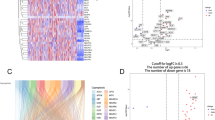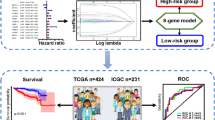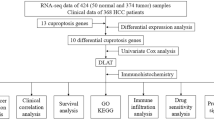Abstract
Objective
Cuproptosis is a novel cell death pathway that was newly discovered in early 2022. However, cuproptosis is still in its infancy in many respects and warrants further research in hepatocellular carcinoma (HCC). This study aimed to analyze the mechanism of cuprptosis in HCC.
Methods
Herein, the tumor microenvironment infiltration landscape of molecular subtypes was illustrated using GSVA, ssGSEA, TIMER, CIBERSORT, and ESTIMATE algorithms based on the expression profile of cuproptosis-related genes (CRGs) from TCGA and GEO databases. Then, the least absolute shrinkage and selection operator regression method was applied to construct a cuproptosis signature to quantify the cuproptosis profile of HCC. Further, we explored the expression of three hub CRGs in cell lines and clinical patient tissues of HCC by Western blotting, qRT-PCR and immunohistochemistry. Finally, we examined the function of dihydrolipoamide S-acetyltransferase (DLAT) in cuproptosis in HCC by loss-of-function strategy, Western blotting and CCK8 assay.
Results
Three distinct molecular subtypes were identified. Cluster 2 had the greatest infiltration of immune cells with best prognosis. The cuproptosis signature was indicative of tumor subtype, immunity, and prognosis for HCC, and specifically, a low cuproptosis score foreshadowed good prognosis. DLAT was highly expressed in liver cancer cell lines and HCC tissues and positively correlated with clinical stage and grade. We also found that potent copper ionophore elesclomol could induce cuproptosis in a copper-dependent manner. Selective Cu++ chelator ammonium tetrathiomolybdate and downregulating DLAT expression by siRNA could effectively inhibit cuproptosis.
Conclusion
Cuproptosis and DLAT as a promising biomarker could help to determine the prognosis of HCC and may offer novel insights for effective treatment.
Similar content being viewed by others
References
Cao M, Luo X, Wu K, et al. Targeting lysosomes in human disease: from basic research to clinical applications. Signal Transduct Target Ther, 2021,6(1):379
Tsvetkov P, Coy S, Petrova B, et al. Copper induces cell death by targeting lipoylated TCA cycle proteins. Science, 2022,375(6586):1254–1261
Lin S, Yang H. Ovarian cancer risk according to circulating zinc and copper concentrations: A metaanalysis and Mendelian randomization study. Clin Nutr, 2021,40(4):2464–2468
Xiao Y, Chen DI, Zhang X, et al. Molecular study on copper-mediated tumor proteasome inhibition and cell death. Int J Oncol, 2010,37(1):81–87
Blockhuys S, Celauro E, Hildesjö C, et al. Defining the human copper proteome and analysis of its expression variation in cancers. Metallomics, 2017,9(2):112–123
Ishida S, Andreux P, Poitry-Yamate C, et al. Bioavailable copper modulates oxidative phosphorylation and growth of tumors. Proc Natl Acad Sci USA, 2013,110(48): 19507–19512
Ge EJ, Bush AI, Casini A, et al. Connecting copper and cancer: from transition metal signalling to metalloplasia. Nat Rev Cancer, 2022,22(2):102–113
Zuo XL, Chen JM, Zhou X, et al. Levels of selenium, zinc, copper, and antioxidant enzyme activity in patients with leukemia. Biol Trace Elem Res, 2006,114(1–3):41–53
Lutsenko S. Human copper homeostasis: a network of interconnected pathways. Curr Opin Chem Biol, 2010,14(2):211–217
Jiang Y, Huo Z, Qi X, et al. Copper-induced tumor cell death mechanisms and antitumor theragnostic applications of copper complexes. Nanomedicine (Lond), 2022,17(5):303–324
Voli F, Valli E, Lerra L, et al. Intratumoral Copper Modulates PD-L1 Expression and Influences Tumor Immune Evasion. Cancer Res, 2020,80(19):4129–4144
Liao Y, Zhao J, Bulek K, et al. Inflammation mobilizes copper metabolism to promote colon tumorigenesis via an IL-17-STEAP4-XIAP axis. Nat Commun, 2020,11(1):900
Chan N, Willis A, Kornhauser N, et al. Influencing the Tumor Microenvironment: A Phase II Study of Copper Depletion Using Tetrathiomolybdate in Patients with Breast Cancer at High Risk for Recurrence and in Preclinical Models of Lung Metastases. Clin Cancer Res, 2017,23(3):666–676
Gupte A, Mumper RJ. Elevated copper and oxidative stress in cancer cells as a target for cancer treatment. Cancer Treat Rev, 2009,35(1):32–46
Yoshii J, Yoshiji H, Kuriyama S, et al. The copper-chelating agent, trientine, suppresses tumor development and angiogenesis in the murine hepatocellular carcinoma cells. Int J Cancer, 2001,94(6):768–773
Chen D, Cui QC, Yang H, et al. Disulfiram, a clinically used anti-alcoholism drug and copper-binding agent, induces apoptotic cell death in breast cancer cultures and xenografts via inhibition of the proteasome activity. Cancer Res, 2006,66(21):10425–10433
Karginova O, Weekley CM, Raoul A, et al. Inhibition of Copper Transport Induces Apoptosis in Triple-Negative Breast Cancer Cells and Suppresses Tumor Angiogenesis. Mol Cancer Ther, 2019,18(5):873–885
Sung H, Ferlay J, Siegel RL, et al. Global Cancer Statistics 2020: GLOBOCAN Estimates of Incidence and Mortality Worldwide for 36 Cancers in 185 Countries. CA Cancer J Clin, 2021,71(3):209–249
Luo XY, Wu KM, He XX. Advances in drug development for hepatocellular carcinoma: clinical trials and potential therapeutic targets. J Exp Clin Cancer Res, 2021,40(1):172
Lv H, Liu X, Zeng X, et al. Comprehensive Analysis of Cuproptosis-Related Genes in Immune Infiltration and Prognosis in Melanoma. Front Pharmacol, 2022,13:930041
Chen Q, Wang Y, Yang L, et al. PM2.5 promotes NSCLC carcinogenesis through translationally and transcriptionally activating DLAT-mediated glycolysis reprograming. J Exp Clin Cancer Res, 2022,41(1):229
Goh WQ, Ow GS, Kuznetsov VA, et al. DLAT subunit of the pyruvate dehydrogenase complex is upregulated in gastric cancer-implications in cancer therapy. Am J Transl Res, 2015,7(6):1140–1151
Stone S, Jiang P, Dayananth P, et al. Complex structure and regulation of the P16 (MTS1) locus. Cancer Res, 1995,55(14):2988–2994
Song W, Ren J, Xiang R, et al. Identification of pyroptosis-related subtypes, the development of a prognosis model, and characterization of tumor microenvironment infiltration in colorectal cancer. Oncoimmunology, 2021,10(1):1987636
Kim Y, Kang JW, Kang J, et al. Novel deep learning-based survival prediction for oral cancer by analyzing tumor-infiltrating lymphocyte profiles through CIBER-SORT. Oncoimmunology, 2021,10(1):1904573
Wang T, Dai L, Shen S, et al. Comprehensive Molecular Analyses of a Macrophage-Related Gene Signature With Regard to Prognosis, Immune Features, and Biomarkers for Immunotherapy in Hepatocellular Carcinoma Based on WGCNA and the LASSO Algorithm. Front Immunol, 2022,13:843408
Tang Z, Kang B, Li C, et al. GEPIA2: an enhanced web server for large-scale expression profiling and interactive analysis. Nucleic Acids Res, 2019,47(W1):W556–W560
Li T, Fan J, Wang B, et al. TIMER: A Web Server for Comprehensive Analysis of Tumor-Infiltrating Immune Cells. Cancer Res, 2017,77(21):e108–e110
Li SR, Bu LL, Cai L. Cuproptosis: lipoylated TCA cycle proteins-mediated novel cell death pathway. Signal Transduct Target Ther, 2022,7(1):158
Buccarelli M, D’Alessandris Q, Matarrese P, et al. Elesclomol-induced increase of mitochondrial reactive oxygen species impairs glioblastoma stem-like cell survival and tumor growth. J Exp Clin Cancer Res, 2021,40(1):228
Wangpaichitr M, Wu C, You M, et al. N′,N′-Dimethyl-N′,N′-bis(phenylcarbonothioyl) Propanedihydrazide (Elesclomol) Selectively Kills Cisplatin Resistant Lung Cancer Cells through Reactive Oxygen Species (ROS). Cancers (Basel), 2009,1(1):23–38
Gao W, Huang Z, Duan J, et al. Elesclomol induces copper-dependent ferroptosis in colorectal cancer cells via degradation of ATP7A. Mol Oncol, 2021,15(12): 3527–3544
O’Day S, Eggermont A, Chiarion-Sileni V, et al. Final results of phase III SYMMETRY study: randomized, double-blind trial of elesclomol plus paclitaxel versus paclitaxel alone as treatment for chemotherapy-naive patients with advanced melanoma. J Clin Oncol, 2013,31(9):1211–1218
Author information
Authors and Affiliations
Corresponding authors
Additional information
Conflict of Interest Statement
The authors have no conflict of interest.
This research was financially supported by grants from the National Natural Science Foundation of China (No. 82073095, No. 82172938 and No. 81670554) and Science and Technology Innovation Cultivation Fund of Zhongnan Hospital of Wuhan University (No. CXPY2020042).
Rights and permissions
About this article
Cite this article
Gao, F., Yuan, Y., Ding, Y. et al. DLAT as a Cuproptosis Promoter and a Molecular Target of Elesclomol in Hepatocellular Carcinoma. CURR MED SCI 43, 526–538 (2023). https://doi.org/10.1007/s11596-023-2755-0
Received:
Accepted:
Published:
Issue Date:
DOI: https://doi.org/10.1007/s11596-023-2755-0




